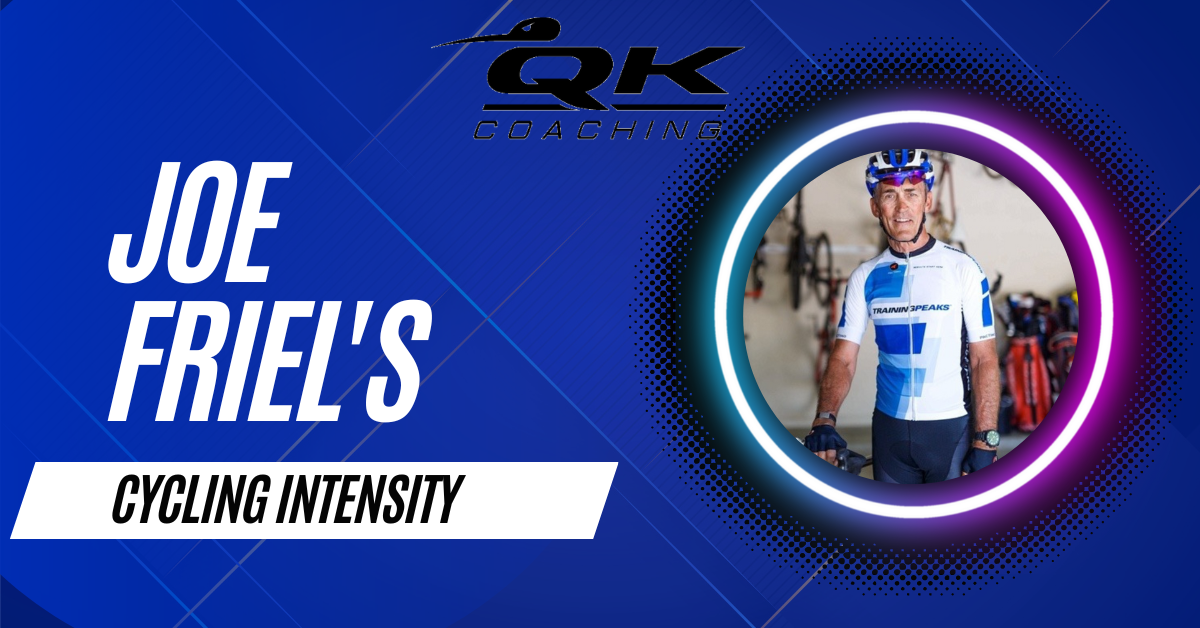How do you measure intensity? So many coaches use so many different methods, power, Heart Rate (HR), three zones, five zones, seven zones?? I’ve been planning a series of weekly articles for over a year now, looking at what different coaches prescribe (or used to prescribe) and why. This is the second article in the series, using Joe Friel’s The Power Meter Handbook as the primary reference.
Last weeks article can be read here.
Joe Friel is considered a world wide guru when it comes to endurance training. Road cyclists, mountain bikers and triathletes. He has written a range of books including The Cyclist’s Training Bible, The Triathlete’s Training Bible, and Ride Inside amongst others. However I must point out the methodology used comes from Andrew Coggan, who will be the subject of a future article.
Joe Friel uses seven power zones:
| % FTP | Description | |
| Zone 1 Active Recovery | < 55 | Very, low level of exercise. Easy spinning with light pedal pressure. Minimal effort and fatigue. Able to maintain a conversation. Used as active recovery between intervals, or after hard workouts or races. |
| Zone 2 Aerobic Endurance | 56 – 75 | Effort and fatigue generally low but increase during prolonged sessions at this intensity. Classic Long, Slow Distance (LSD). Able to maintain a conversation. Age group Ironman intensity. 90min to 2 hours at Zone 2 tolerated well, longer sessions also comfortable but require great recovery. |
| Zone 3 Tempo | 76 – 90 | Greater effort and fatigue compared with Zone 2. Breathing deeper and more rhythmic than Zone 2, conversation somewhat broken. Typical of a brisk bunch ride; sitting in on a fast road race; elite Ironman, age group Ironman 70.3; or MtB Marathon event. 20 to 60 minutes steady rides. |
| Zone 4 Lactate Threshold | 91 – 105 | Riding at FTP. Effort and fatigue high. Breathing laboured and conversation difficult. Used for triathlons and time trials lasting 30 to 90 minutes duration. Typically trained with intervals six to twenty minutes long, with a work:rest ratio of about 4:1. |
| Zone 5 VO2max | 106 – 120 | Effort and fatigue in Zone 5 very high. Conversation not possible. Typical for surges or breaks in road cycling, not typically used in a triathlon except for maybe draft legal events and short hills.. Typically trained with intervals two to six minutes long, with a work:rest ratio of about 1:1. Accumulating more than 20 to 30 minutes at this intensity within a workout is difficult. |
| Zone 6 Anaerobic Capacity | 121 – 150 | Effort and fatigue in Zone 5 extremely high. Short episodes at this intensity common in road races, criteriums & MtB races, but not in triathlons. High intensity intervals of 30 seconds to two minutes duration. |
| Zone 7 Sprint Power | > 150 | Very short, very high-intensity efforts. Standing starts on the track and short sprints of less than 30 seconds in road races. Zone 7 places great stress on muscles than on energy systems. |
To calculate these Power Training Zone you need to have your Functional Threshold Power (FTP) which in some of Friel’s earlier books is referred to as CP60 or Critical Power 60 minutes, which is the intensity that you can maintain for a full 60 minutes.
With my focus primarily on coaching beginner and recreational triathletes there is limited need for my athletes to use Zone 6 & Zone 7, however where there is a requirement to train at those intensities the workouts reflect that.
Here is how I manage Intensity for cycling:
In The Power Meter Handbook, Joe Friel offers cyclists and triathletes a simple user’s guide to using a power meter for big performance gains.
In simple language, the most trusted coach in endurance sports makes understanding a power meter easy, no advanced degrees or tech savvy required.
Cyclists and triathletes will master the basics to reveal how powerful they are. Focusing on their most important data, they’ll discover hidden power, refine their pacing, and find out how many matches they can burn on any given day.
Once they understand the fundamentals, Friel will show how to apply his proven training approach to gain big performance in road races, time trials, triathlons, and century rides.
With The Power Meter Handbook, riders will:
- Precisely match their training to their race season
- Push their limits step by step
- Track fitness changes–reliably and accurately
- Peak predictably for key events
- Vastly improve training efficiencyPower meters aren’t just for the pros or racers anymore. Now The Power Meter Handbook makes it easy for any cyclist or triathlete to find new speed with cycling’s most advanced gear.
